Bindaetteok is a savory pancake and a popular item on many menus. People enjoy the dish not only in the winter but also at banquets, such as weddings or hoegap 60th birthday parties.
In the past, it was called “binja tteok," or a pancake for poor people, as binja (貧子) means the poor. These days, however, thanks to its delicious taste, it's called simply bindaetteok, as bindae means distinguished guests.
Though it's called a -tteok, which normally implies something made from rice cake, it's actually a pancake fried in oil. It's made from ground mung beans, chopped and seasoned pork, vegetables and kimchi. Originally, bindaetteok was made so as to serve roasted or fried meat at a ceremonial altar or at the dining table. The meat on the top was for the host of the house, and the bottom -- the bindaetteok -- was for the poor or for those who did the chores on the banquet day.
As the oil from the meat made the pancake tastier, along with the nutty taste of the mung bean, the pancakes were good enough to fill the stomach, not to mention they tend to be large and thick. Thanks to its taste and size, bindaetteok gradually became a popular menu item in and of itself.
The oldest record of a bindaetteok recipe can be found in "Eumsik Dimibang" (음식 디미방, 飮食 知味方), the first cookbook written in Korean, a collection from the 17th century. In this book, the pancake is called binjyabeop (빈쟈법). The old recipe instructs people to add some red bean filling to the mixture, unlike today’s method.
These days, many people enjoy bindaetteok, even if it's not eaten on a special occasion. Some enjoy the pancake on rainy or snowy days, and that’s because the sound of frying the pancake in oil is similar to that of the rain drops.
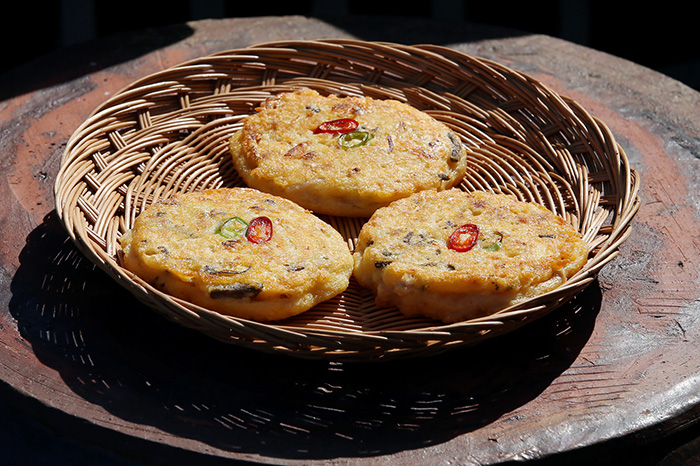
** Ingredients
90 grams (0.5 cups) thin skin mung bean (거푸녹두, geopi-nokdu)
1 gram (0.25 teaspoons) salt
110 grams water
40 grams cabbage kimchi
20 grams soaked bracken
30 grams minced pork
50 grams mung bean sprouts
600 grams (3 cups) water
2 grams (0.5 teaspoons) salt
5 grams or a third of a green pepper
5 grams or a quarter of a red pepper
26 grams (2 tablespoons) oil
Seasoning sauce:
3 grams (0.5 teaspoons) soy sauce
4.5 grams (1 teaspoon) minced green onions
2.8 grams (0.5 teaspoons) minced garlic
0.1 grams ground black pepper
2 grams (0.5 teaspoons) sesame oil
Mung bean seasoning:
0.5 grams (0.125 teaspoons) salt
2 grams (0.5 teaspoons) sesame oil
Vinegar soy sauce:
18 grams (1 tablespoon) soy sauce
15 grams (1 tablespoon) vinegar
15 grams (1 tablespoon) water
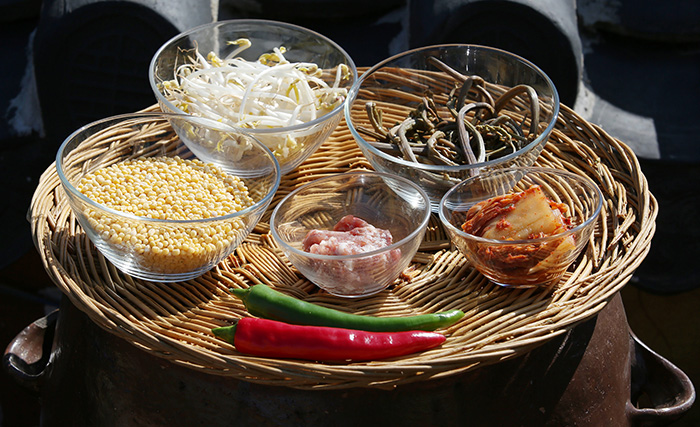
** Preparation
1. Wash the thin skin mung beans (geopi-nokdu). Soak them in water for eight hours. Skin them by rubbing them with your hands. Drain off the water through a strainer.
2. Remove the insides of the cabbage kimchi. Squeeze out any kimchi juice. Slice the kimchi into 1 centimeter slices.
3. Remove the tough parts of the soaked bracken. Cut it into 2 centimeter strips. Mix it with the pork and season it with the seasoning sauce. Remove the tails of the mung bean sprouts and wash them cleanly.
4. Cut the green and red peppers into diagonal slices that are 1 centimeter long and 0.2 centimeters. Remove the seeds by shaking them.
5. Blend the vinegar soy sauce.
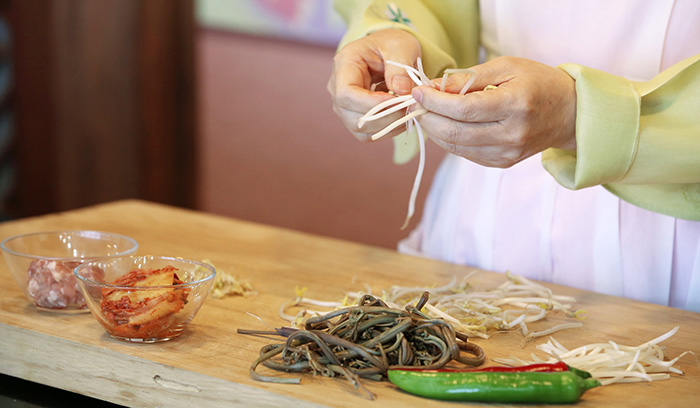
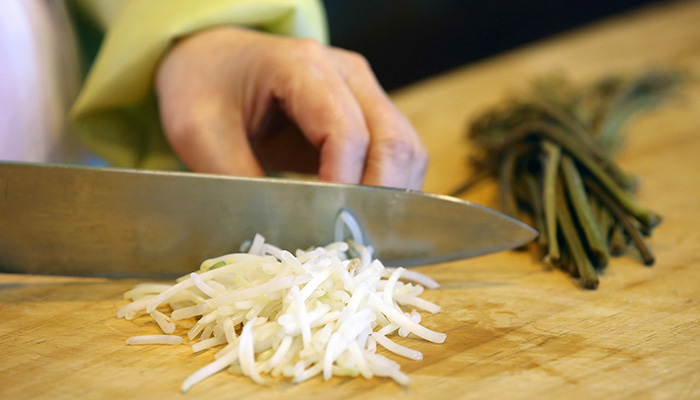
** Recipe
1. Put the soaked mung beans and water into a grinder. Grind them for 1 minute. Season them with salt.
2. Pour the water into a pot. Heat it over high for 3 minutes. When it boils, scald the mung bean sprouts (35 grams) with salt for 2 minutes. Cut them into 2-centimeter slices and season them with the mung bean seasoning.
3. Mix them with the cabbage kimchi, bracken and pork.
4. Preheat a frying pan with the oil. Over a medium heat, make round disks with the ground mung bean, about 5-6 centimeters in diameter, and put the seasoned vegetables and pork on top of them.
5. Add 18 grams (1 tablespoon) of ground mung bean and top it with the green and red pepper slices. Fry one side for 4 minutes and the second side for 2 minutes. It should be a yellowish pancake. Serve with the vinegar soy sauce.
Managed by Yoon Sojung
Korea.net Staff Writer
Photos: Jeon Han
In cooperation with the Institute of Traditional Korean Food (ITKF)
Recipe from “The Beauty of Korean Food: 100 Best-Loved Recipes”
arete@korea.kr
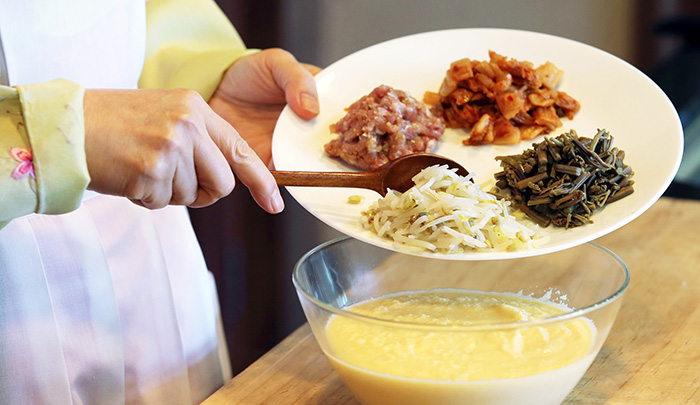
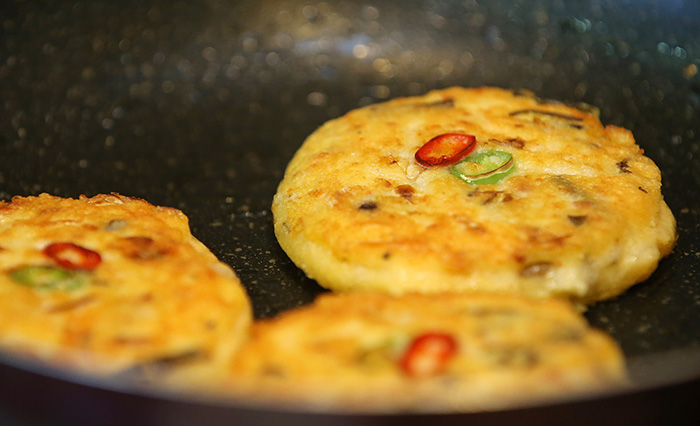
In the past, it was called “binja tteok," or a pancake for poor people, as binja (貧子) means the poor. These days, however, thanks to its delicious taste, it's called simply bindaetteok, as bindae means distinguished guests.
Though it's called a -tteok, which normally implies something made from rice cake, it's actually a pancake fried in oil. It's made from ground mung beans, chopped and seasoned pork, vegetables and kimchi. Originally, bindaetteok was made so as to serve roasted or fried meat at a ceremonial altar or at the dining table. The meat on the top was for the host of the house, and the bottom -- the bindaetteok -- was for the poor or for those who did the chores on the banquet day.
As the oil from the meat made the pancake tastier, along with the nutty taste of the mung bean, the pancakes were good enough to fill the stomach, not to mention they tend to be large and thick. Thanks to its taste and size, bindaetteok gradually became a popular menu item in and of itself.
The oldest record of a bindaetteok recipe can be found in "Eumsik Dimibang" (음식 디미방, 飮食 知味方), the first cookbook written in Korean, a collection from the 17th century. In this book, the pancake is called binjyabeop (빈쟈법). The old recipe instructs people to add some red bean filling to the mixture, unlike today’s method.
These days, many people enjoy bindaetteok, even if it's not eaten on a special occasion. Some enjoy the pancake on rainy or snowy days, and that’s because the sound of frying the pancake in oil is similar to that of the rain drops.

Bindaetteok is a popular menu item, not only in the winter but also at banquets throughout the year.
** Ingredients
90 grams (0.5 cups) thin skin mung bean (거푸녹두, geopi-nokdu)
1 gram (0.25 teaspoons) salt
110 grams water
40 grams cabbage kimchi
20 grams soaked bracken
30 grams minced pork
50 grams mung bean sprouts
600 grams (3 cups) water
2 grams (0.5 teaspoons) salt
5 grams or a third of a green pepper
5 grams or a quarter of a red pepper
26 grams (2 tablespoons) oil
Seasoning sauce:
3 grams (0.5 teaspoons) soy sauce
4.5 grams (1 teaspoon) minced green onions
2.8 grams (0.5 teaspoons) minced garlic
0.1 grams ground black pepper
2 grams (0.5 teaspoons) sesame oil
Mung bean seasoning:
0.5 grams (0.125 teaspoons) salt
2 grams (0.5 teaspoons) sesame oil
Vinegar soy sauce:
18 grams (1 tablespoon) soy sauce
15 grams (1 tablespoon) vinegar
15 grams (1 tablespoon) water

The main ingredients for bindaetteok are thin skin mung beans, pork, bean sprouts, braken, kimchi and then green and red peppers.
** Preparation
1. Wash the thin skin mung beans (geopi-nokdu). Soak them in water for eight hours. Skin them by rubbing them with your hands. Drain off the water through a strainer.
2. Remove the insides of the cabbage kimchi. Squeeze out any kimchi juice. Slice the kimchi into 1 centimeter slices.
3. Remove the tough parts of the soaked bracken. Cut it into 2 centimeter strips. Mix it with the pork and season it with the seasoning sauce. Remove the tails of the mung bean sprouts and wash them cleanly.
4. Cut the green and red peppers into diagonal slices that are 1 centimeter long and 0.2 centimeters. Remove the seeds by shaking them.
5. Blend the vinegar soy sauce.

Remove the tough parts of the soaked bracken. Remove the tails of the bean sprouts and wash them in water.

Cut the trimmed and soaked braken and bean sprouts into 2-centimeter slices long.
** Recipe
1. Put the soaked mung beans and water into a grinder. Grind them for 1 minute. Season them with salt.
2. Pour the water into a pot. Heat it over high for 3 minutes. When it boils, scald the mung bean sprouts (35 grams) with salt for 2 minutes. Cut them into 2-centimeter slices and season them with the mung bean seasoning.
3. Mix them with the cabbage kimchi, bracken and pork.
4. Preheat a frying pan with the oil. Over a medium heat, make round disks with the ground mung bean, about 5-6 centimeters in diameter, and put the seasoned vegetables and pork on top of them.
5. Add 18 grams (1 tablespoon) of ground mung bean and top it with the green and red pepper slices. Fry one side for 4 minutes and the second side for 2 minutes. It should be a yellowish pancake. Serve with the vinegar soy sauce.
Managed by Yoon Sojung
Korea.net Staff Writer
Photos: Jeon Han
In cooperation with the Institute of Traditional Korean Food (ITKF)
Recipe from “The Beauty of Korean Food: 100 Best-Loved Recipes”
arete@korea.kr

Add kimchi, braken, bean sprouts and pork to the bowl of processed mung beans to make the mixture.

Add the mixture to a preheated frying pan with oil. Form the patties into round shapes. Cook them for 5 or 6 minutes over a medium heat, until the pancake turns a golden yellow.